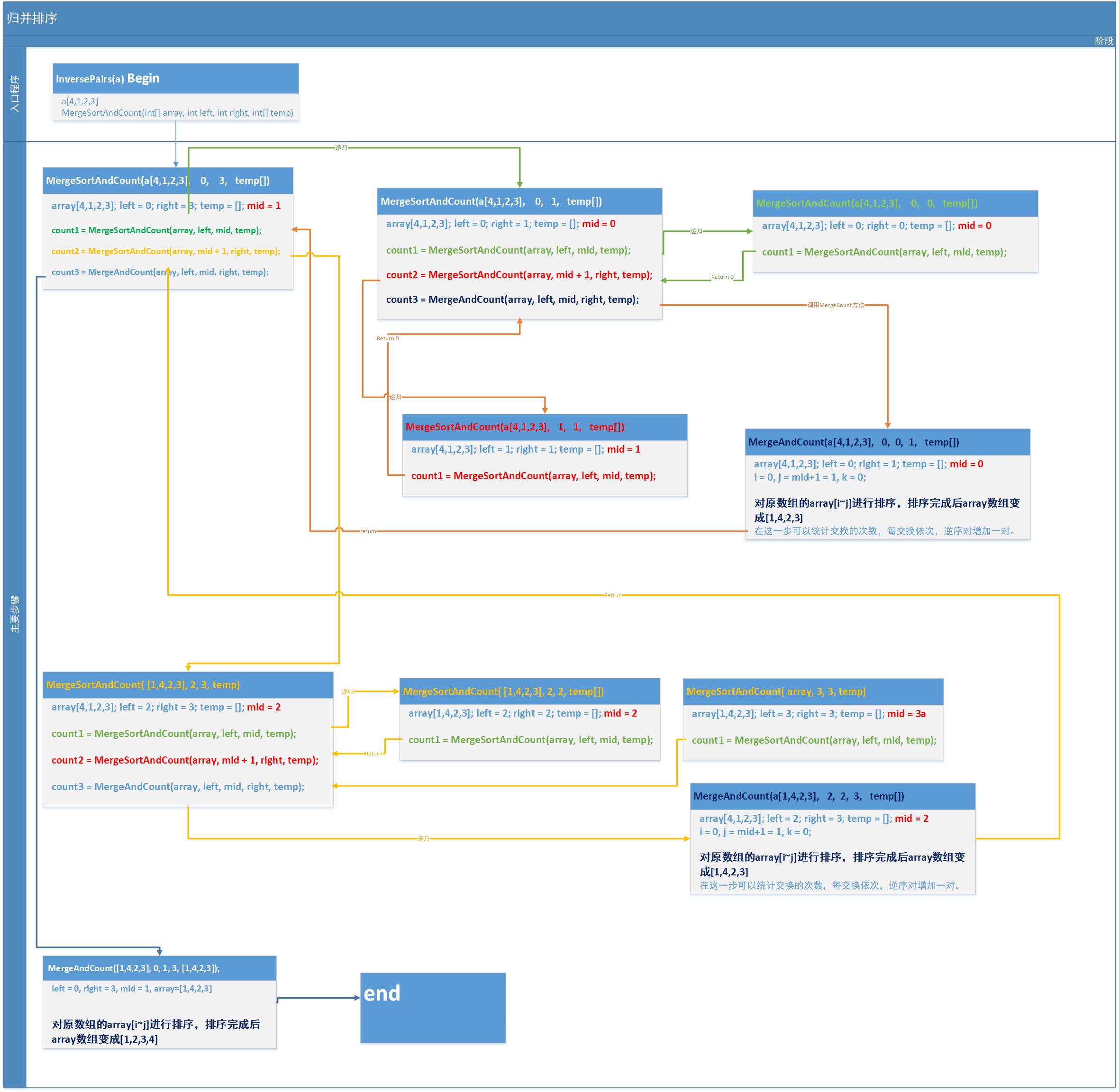逆序对统计
最近写算法题的时候又遇到了这类问题:在数组中的两个数字,如果前面一个数字大于后面的数字,则这两个数字组成一个逆序对。输入一个数组,求出这个数组中的逆序对的总数P。输入:1,2,3,4,5,6,7,0输出: 7可以从上面得知,逆序对分别为:<1,0> <2,0> <3,0> <4,0> <5,0> <6,0> <7,0>
这里问题,一个所有人都能想到的求解方法就是暴力搜索:用两层for循环将数组中的元素全部两两比较一遍,就能得到所有的逆序对数。
当然这样的做法也不是不行,但是效果是时间效率非常的低下,时间复杂度是O(n^2);在数据量很大的时候,响应时间会非常的久,这在算法上是不能接受的。
今天我们学习另一种思想:Divide And Conquer(分而治之—分治思想),它的核心思想就是:大事化小,通过解决多个子问题来解决大问题。
这个问题的解决思路是和归并排序的思想类似的。
话不多说先看代码: (可以用归并排序来作为带入)
1 | public class 数组逆向序对 { |
直接去读这段代码还是有些吃力的,主要有递归程序在,容易把我们绕晕,所以我们以归并排序作为基本思想,来慢慢解决这个问题:
归并排序
归并排序,中国人翻译算法的名字的时候通常使用它们的具体含义来命名,这里归并排序也不理外,很容易理解的是,这个排序算法找中肯定包含着:归类与合并,这两个步骤。
归类处理,然后合并,这种思想就是分治——分而治之也就是Divide and conquer。
归并排序的主要思想
我们上面的找逆序对的问题,其实就是一个简单的归并排序问题,如果你能够充分的理解归并排序,那么上面的找逆序对的问题就不是什么难题。
对于排序,我们知道,它最终的目的是将数据进行有序化,是会对数据进行位置交换的算法。(归并排序是一种稳定的排序算法)。它是通过将一个长度为n的数组分成左右两个部分,通常以n/2作为
下面我们通过简单的例子来进行讲解,会做到详尽周到,希望能对自己和他人的理解有所帮助。
实例
比如我们有一个数组包含4个元素[4,1,2,3],我们希望通过归并排序,将这个数组进行排序。
我们可以通过下面的代码进行实现:1
2
3
4
5
6
7
8
9
10
11
12
13
14
15
16
17
18
19
20
21
22
23
24
25
26
27
28
29
30
31
32
33
34
35
36
37
38
39
40
41
42
43
44
45
46
47public class 数组逆向序对 {
public static void main(String[] args) {
数组逆向序对 nx = new 数组逆向序对();
int[] a = [4,1,2,3};
System.out.println(nx.InversePairs(a));
}
public int InversePairs(int[] array) {
int n = array.length;
int[] temp = new int[n];
long ans = MergeSortAndCount(array, 0, n - 1, temp);
return (int) ans;
}
public long MergeSortAndCount(int[] array, int left, int right, int[] temp) {
if (left >= right) return 0;
int mid = (left + right) / 2;
long count1 = MergeSortAndCount(array, left, mid, temp);
long count2 = MergeSortAndCount(array, mid + 1, right, temp);
long count3 = MergeAndCount(array, left, mid, right, temp);
return (count1 + count2 + count3) % 1000000007;
}
public long MergeAndCount(int[] array, int left, int mid, int right, int[] temp) {
int i = left;
int j = mid + 1;
int k = left;
long cnt = 0;
while (i <= mid && j <= right) {
if (array[i] <= array[j]) {
temp[k++] = array[i++];
} else {
temp[k++] = array[j++];
}
}
while (i <= mid) temp[k++] = array[i++];
while (j <= right) temp[k++] = array[j++];
for (i = left; i <= right; ++i) {
array[i] = temp[i];
}
return cnt;
}
}
这个代码与我们上面缩写的代码仅仅少一行 cnt += mid - i + 1;。而他们的实现过程是一模一样的,我们一点点对代码进行分析。
我们从InversePairs开始:它调用了MergeSortAndCount方法,而MergeSortAndCount方法又调用了MergeAndCount方法。这中间涉及到递归调用,用脑子想的办法去理解可能会有些复杂,我花了一个逻辑调用图,来帮助我们理解归并排序。 归并排序的要点在于,一个是递归,一个是将左右两个部分进行对比排序,如果没有这个递归操作,那么仅仅能保证整个数组以mid为中心,右边比左边大,但是不能保证左右两侧都是有序的,带上递归后,左右两侧分别一直进行递归比较操作,知道这个小的比较区域只剩两个元素,也就完成了子区间的比较。

